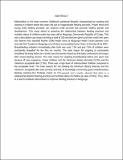Relationship between Feeding Practices and Nutritional Status of Children under the Age of Two Years in Mugunga, Democratic Republic of Congo

View/
Date
2018-09Author
Mafuko, Barigira Justin
Type
ThesisLanguage
enMetadata
Show full item recordAbstract
Malnutrition is the most common childhood nutritional disorder characterised by stunting and wasting in children below two years old due to inappropriate feeding practices. Proper infant and young child feeding practices can improve child survival and promote healthy growth and development. This study aimed at assessing the relationship between feeding practices and nutrition status of children under two years old in Mugunga, Democratic Republic of Congo. This was a descriptive case study involving a total of 206 women/care givers and their under two years old children who attended Mother Child Health clinic at Mugunga Health Centre between June and July 2017 located in Mugunga, one of slums surrounding Goma Town, in the East of the DRC. Breastfeeding initiation immediately after birth was only 7.3% and just 7.8% of children were exclusively breastfed for the first six months. The main reason for stopping to exclusively breastfeed the baby before six months was that women found out that baby continued to be hungry after breast feeding session. The main reason for stopping breastfeeding before two years was because of new pregnancy. Fewer children met the minimum dietary diversity (5.3%) and the minimum acceptable diet (7.3%). There was a high level of malnourished children compared to the acceptable level. The main reasons for not meeting the minimum dietary diversity and the minimum acceptable diet were poverty and lack of knowledge concerning good complementary feeding practices.Our findings, based on Chi-squared test’s results, showed that there is a relationship between feeding practices and nutrition status of children (p value <0.001). Thus, there is a need to institute interventions to improve feeding practices in Mugunga.
Publisher
KeMU
Subject
Human Nutrition and DieteticsDescription
A thesis submitted in partial fulfillment for the degree of Master of Science in Human Nutrition of Kenya Methodist University.
Collections
- Master of Science in Human Nutrition [20]
- Thesis [44]
